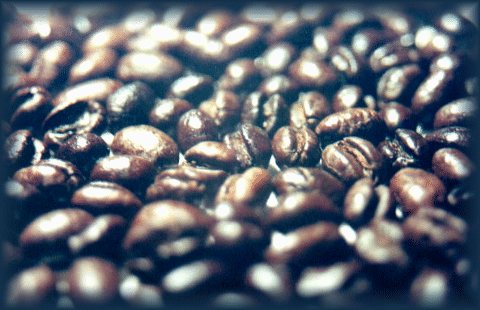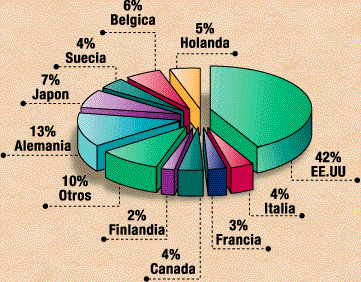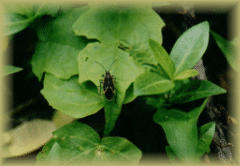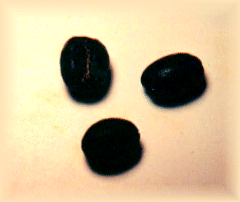
Environmental and Cultural Implications of
Guatemalan Coffee Production


 |
|
||


 I. Identification
I. Identification
Map of Guatemala
This case study focuses on Guatemalan coffee, but it is very likely that other countries where coffee is harvested experience the same dilemmas. Coffee in Guatemala is an old export crop. Currently, a high percentage of Guatemalan coffee is shade grown. Shade grown coffee, according to the Seattle Audobon Organization, is defined as "coffee grown under a canopy of diverse species of trees that provides a viable winter habitat for migratory birds. The benefits of shade grown coffee are many. In the first place, it requires a smaller amount of fertilizers, and pesticides. Also, the forests that supply the shade for the coffee plants provide a haven for migratory birds and endemic bird species, as well as a home for many insects and mammals.There are other consequences in the production of coffee besides the environmental ones. These include the difficulty in certifying coffee as organic and/or shade grown, and issues of labor rights.
Coffee as a product entails a number of implications that are often overlooked by its consumers. The consumer must ask a number of questions in order for him/her to know the positive and negative aspects in environmental, economic, and moral terms that are involved in the production of the coffee that they are consuming: How is it produced? Who produces it? What are the implications for those who produce it? How does it affect the environment? Seldom does the consumer think about what is behind the label of their coffee beans.
There has been a growing trend in the coffee industry. Modern techniques that produce a higher yield of coffee, that involve 'sun farming', slowly have been abandoned by a small number of producers. These modern techniques include the need to strip the forests to clear the land, higher use of pesticides and fertilizers, and soil erosion as a result of these practices. Sun farming has the advantage of producing a higher yield, but it also requires the use of agro-chemicals that cause several environmental problems. The use of these chemicals causes soil erosion, soil compression, there is a loss of bio-diversity, and creates health concerns for humans (Fishbein 1). Coffee producers have gone back to growing coffee under the shade of forests. This yields a product that is organic and that causes less environmental damage. Benefits of shade produce coffee include a higher yield of organic matter, protection of the soil from erosion and compression, and extended longevity of the coffee plants.
This is an important step that many producers have been taking as a result of a higher demand for an organic product. Yet, other producers have gone a step further. They have incorporated shade coffee practices with other factors to produce sustainable coffee both in environmental terms and human terms. These factors include monitoring closely the use of water, taking advantage of renewable energy available during coffee processing, utilizing discarded materials (such as using coffee pulp as fertilizer), and most importantly an effort to recognize that their 'manual labor' is the human factor in coffee production.
According to ANACAFE (Guatemalan Coffee Association, a non-profit organization that promotes Guatemala's coffee agro-industry), mostly all of Guatemalan coffee grows under shade trees. Many Guatemalan producers are one step ahead because, to a certain extent, they are already producing sustainable coffee. On the other hand, another factor still needs to be addressed. Coffee in Guatemala is an old crop. It is one of the few crops that peasants focus on, since it is one of the most important exports.
In Guatemala, coffee is produced by two groups of people: small independent farmers and large coffee plantations. Independent farmers face a number of difficulties starting with the transportation of the harvested coffee to processing plants which is usually very far from their plantations. It is not uncommon for them to encounter individuals who want to steal their harvested coffee at gunpoint from them when they are in their way to the processing plants. Finally, if they do make the journey safely, they must be satisfied with the payment of $14.00 for every 100-pound sack. A family with half an acre of coffee might be able to produce 2,500 pounds if they are lucky. (Abel 38). Workers in large plantations are not better off. These workers are paid $0.023 per pound. A large family, working together might make $6.90 a day at the peak season during coffee harvesting, giving them an annual income of $350.00 (Abel 39).
To achieve a sustainable product, producers must carefully look at their entire practice from the beginning of it (production) to the end (consumption). The product needs to be profitable for every link of the chain, and both the environment and the labor force must be nourished (Fishbein 3).
The change that is needed will not come from producers or from the introduction of standards by the government. Here is where purchasing power matters most. Importers of coffee are the ones who have the power to dictate if they want to purchase sustainable coffee or not. The United States is the most important market for this coffee since U.S. consumers are well educated in environmental issues, and they are conscious of their product choices. This market is entirely consumer driven (Perkins 1). In fact, 42% of Guatemalan coffee is exported to the United States.
Related Cases
(1)Coffee
(2)Shadecof
(3)Ethcoff
(4)Indiatea
(5)Kenyatea
(6)Snowpea
(7)Pisco
(8)Chiapas
(9)Peten
Key Words
(1)Food
(2)Snamer
(3)Bird
(4)Defor
(5)Habit
C. Stoute
Note Date: May 9th, 2000
 II. Legal Clusters
II. Legal ClustersDiscourse: Agree
Status: Inprogress
Other parties that could be potentially affected: all of the other coffee producing countries, and all countries that import coffee.
Standing: NGO There is no degree of consensus on the issue of shade coffee farming. There is no regulatory international "coffee board" that establishes any sort of quality control. Quality control is mainly market driven: the best producers will be able to sell their coffee at higher prices. On the other hand, many coffee producers already have admitted that "sun-farming" causes problems at many levels, but many are reluctant to go back to shade coffee farming because that entails new plants, less output, etc. Another factor that is important is the fact that the only criteria available for certification of shade grown coffee is the one established by the Smithsonian Migratory Bird Center. However, there is no organization in charge of ensuring that the criteria are being met on a regular basis. The criteria that was established by the Smithsonian Migratory Bird Center is only useful if the coffee farmers chose to implement it. The decision has to be taken by the industry in particular countries, unless an international coffee board is established.
 III. Geographic Clusters
III. Geographic Clustersa. Geographic Domain: North America
b. Geographic Site: Southern North America
c. Geographic Impact: Guatemala
Sub-state: No
Habitat Type: Trop (Tropical Rainy Forest and Savanna)
 IV. Trade Clusters
IV. Trade ClustersCategory: REGSTD (Regulatory Standard---optional standard (SMBC) that regulates shade coffee production---
The amount of coffee that is imported into the US is mostly determined by consumption. Also, it might be consumer driven to some extent because of the benefits of shade coffee farming. Another factor is the fact that the philosophy behind shade coffee production goes hand in hand with the ideology of environmental groups in the United States.
Impact: Indirect
a. Directly Related to Product: Yes (Coffee)
b. Indirectly Related to Product: No
c. Not Related to Product: No
d. Related to Process: Yes (Habitat Loss)
Product: Coffee
Industry Output:
 In 1998, Guatemala produced 5.2 million bags (each containing 100 pounds
of coffee) from a cultivated area of 619,200 acres.
In 1998, Guatemala produced 5.2 million bags (each containing 100 pounds
of coffee) from a cultivated area of 619,200 acres.
Employment:
Plantation workers receive $.023 per pound. During the peak period of the harvesting season, a family of six that works in a plantation as coffee pickers may earn about $6.90 a day. During the non-peak period the family may earn as little as $0.62 per day (Abell 39).
Sector: FOOD
Case Exporter: Guatemala
In the harvest year of 1997-1998, Guatemala exported around 5.2 millions of 100 pound bags (Source ANACAFE)
| 1994 | 1995 | 1996 | 1997 | 1998 |
| 318,556 | 539,748 | 473,020 | 589,590 | 586,797 |
| 1.United States |
| 2.Germany |
| 3.Japan |
| 4.Belgium |
| 5.Netherlands |
| 6.Sweden |
| 7.Canada |
| 8.Italy |
| 9.France |
| 10.Finland |
As can be seen above, Guatemala is the sixth largest exporter of coffee (when measured in U.S.$). The United States is the largest importer of coffee in the international market. As a result, it makes sense for the U.S. to be the targeted market for Guatemalan coffee export. Guatemala also exports, on a much smaller scale, to seven other importers of coffee on the list.

Main Destinations for Guatemalan Coffee (Source ANACAFE)
| 1.Brazil | 2,604,674 |
| 2. Colombia | 2,038,810 |
| 3.Germany | 1,028,30 |
| 4.Mexico | 761,764 |
| 5.Indonesia | 615,778 |
| 6.Guatemala | 586,797 |
| 7.Belgium-Lux | 470, 435 |
| 8.India | 455,032 (1997 figures) |
| 9.Costa Rica | 419,427 (1997 figures) |
| 10.El Salvador | 324,514 |
Leading Exporters (US$):
As can be seen above, Guatemala is the sixth largest exporter of coffee (when measured in U.S.$). The United States is the largest importer of coffee in the international market. As a result, it makes sense for the U.S. to be the targeted market for Guatemalan coffee export. Guatemala also exports, on a much smaller scale, to seven other importers of coffee on the list.
Leading Importers (US$):
| 1.U.S/Puerto Rico/U.S. Virgin Islands | 3,533,521 |
| 2. Germany | 2,461,979 |
| 3.Japan | 1,176,410 |
| 4.France | 1,147,822 |
| 5.Italy | 937,546 |
| 6.Belgium-Lux | 670,938 |
| 7.United Kingdom | 636,942 |
| 8.Canada | 619,945 |
| 9.Spain | 547,471 |
| 10.Netherlands | 423,198 |
(b)Leading importer of Guatemalan Coffee
Unlike other countries, the United States is a key importer because it has many interest groups that have purchasing power. Guatemala exports a large percentage of their coffee to the United States (42%). This is probably a result of environmental groups that are interested in Guatemalan coffee because a large percentage of their coffee crops are organic, and are also considered as 'shade coffee'. Shade coffee benefits mostly birds, insects, some species of mammals, and the land.
 V. Environment Clusters
V. Environment Clustersa. Habitat: DEFOR (Deforestation)
b. Species Loss SPLA (Air)

Name: neotropical migrant birds, endemic bird species (humingbirds, swallows, warblers, orioles, tanagers), mammals, and insects.
Type: 150 species of neotropical migrant birds (Strauss 48), 24 species of mammals, ants, beetles,epiphytes, and amphibians (SMBC figures).
Diversity: VULNERABLE
The 150 species of birds are specially at risk because "sun" coffee plantations used be the winter homes of these migratory birds. Shade coffee plantations provide these birds with a place to stay during their annual winter migration. In the case of the insects, coffee plantations might actually benefit from them because they keep unwanted insect species away making the use of large amounts of pesticides unnecessary. In previous studies conducted in Mexico and Colombia it was found that "sun" coffee plantations had 94%-97% less bird species than shade coffee plantations.
Impact: High-Medium
Effect: Product Effects
1.Urgency:LOW Currently, shade grown coffee provides for 150 species of migratory birds, while coffee that is not shade grown provides a habitat for only 20-50 species.
2.Lifetime of Species: NA
LIKE (Shade grown coffee)
 VI. Other Factors
VI. Other Factors
Families that live in the highlands of Guatemala have few alternatives when it comes to employment. Education is expensive for farmers that can barely make enought money to provide their families with the basic necessities. As a result they do not have skills that can guarantee them better jobs. Those who do not own land have the option of either working for large plantations thorughout the year, where they are usually paid less than the minimum salary, or work as seasonal workers. The two main crops that can provide for these types of employment are coffee and sugar. Families must chose between the two, because they are harvested at the same time and one is located in the highlands, while the other is located in coastal regions. An important factor in this phenomenon is the fact that 2% of the population of Guatemala owns 80% of the land.
Human Rights: YES
---Spotlight: Guatemala. Population Today 27.1 (1999):7-8.
Abell, John "The Neoliberal World Order: the View from the Highlands of Guatemala" NACLA Report on the Americas 13.1 (1999):37-41.
ANACAFE Organization [Web Page] http://anacafe.org/ [Accessed Feb 2000].
Bourbeau, Heather. "Grounds for Dissent" The Washington Monthly 31.10 (1999):54-55. Cambranes, J.C. Coffee and peasants: the origins of the modern plantation economy in Guatemala, 1852-1897. 1985.
Cone, Jim. "Roasting and Pollution Control"--article [web page] http://www.stoneworks.com/scaa1_archive/cone.html [Accessed March 02 2000]
Fishbein, Bill. "Defining Sustainable Coffee"--article [web page] http://www.stoneworks.com/scaa1_archive/fishbein.html [Accessed March 02 2000]
Hefied, Amine. Pictures [cents, coffee beans, insect] April, 2000.
Lehoucq, Fabrice Edouard. Coffee and Power: Revolution and the Rise of Democracy in Central America: Reform and Revolution in Costa Rica and Guatemala, 1870-1950.
Seattle Audobon. "Coffee and Birds: Making the Connection"--article [web page] http://www.seattleaudobon.org/coffee/home.html [Accessed March 02 2000]
Strauss, Karyn. "Rainforest Cafe to serve certified shade-grown coffee" Nation's Restaurant News 33.21 (1999):48-49.
Williams,Robert. States and Social Evolution: coffee and the rise of national governments in Central America. 1994.